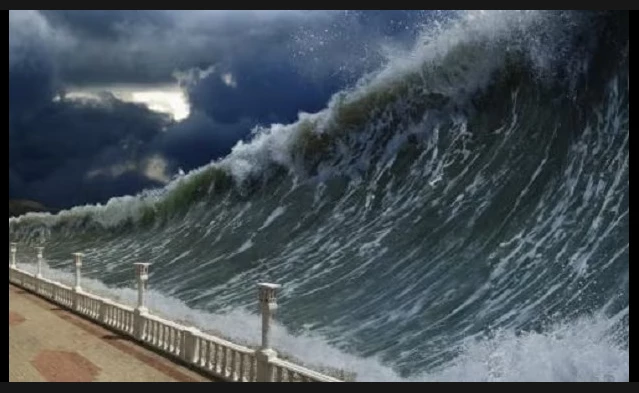First tsunami waves hit after series of earthquakes rattles Japan

Stay tuned with 24 News HD Android App

The first tsunami waves, some more than a metre high, arrived on the north coast of central Japan on Monday after a series of powerful earthquakes rocked the region.
Waves as high as 1.2 meters (four feet) hit Wajima port in Ishikawa prefecture at 4:21 pm (0721 GMT), the Japan Meteorological Agency said, after the US Geological Survey and other agencies registered a major 7.5 magnitude quake little more than 10 minutes earlier.
The powerful earthquake hit central Japan, the USGS said, prompting tsunami warnings and authorities to urge people in the area to move to higher ground. "All residents must evacuate immediately to higher ground," national broadcaster NHK said after the quake hit the Noto region in Ishikawa prefecture around 4:10 pm (0710 GMT).
Hazardous tsunami waves were possible within 300 kilometres (190 miles) of the quake's epicentre along the Japan coast, the Hawaii-based Pacific Tsunami Warning Center said.
Tsunami is the scariest thing #earthquake #Japan pic.twitter.com/ik2FKNBYdG
— Barkin • ברקין • Баркин • 巴尔金 (@B2RKN) January 1, 2024
A tsunami of 1.2 metres was confirmed to have arrived in Wajima city in Ishikawa prefecture. But a much higher tsunami of five metres was expected to arrive in Noto in the same region, the Japan Meterological Agency (JMA) said.
The JMA said the Noto region, on the Sea of Japan side of Japan's main island of Honshu, experienced a rapid succession of quakes, starting with a 5.7 magnitude tremor at 4:06 pm local time.
A massive earthquake has struck Ishikawa Prefecture, central Japan. A tsunami warning has been issued for Niigata, Toyama, Ishikawa prefectures of the Japan Sea side of the country. People in these area must evacuate immediately.https://t.co/bZpiKm8wIN pic.twitter.com/hl9ERDhF8C
— NHK WORLD News (@NHKWORLD_News) January 1, 2024
This was followed by a 7.6-magnitude quake at 4:10 pm, a 6.1 magnitude quake at 4:18 pm, a 4.5 magnitude one at 4:23 pm, a 4.6 magnitude quake at 4:29 pm, and 4.8 magnitude quake at 4:32 pm.
Another quake with a magnitude of 6.2 hit soon after, the US Geological Survey said.
The largest of the quakes prompted broadcasters to switch to special programming and make urgent calls for affected residents to leave for higher ground. "We realise your home, your belongings are all precious to you, but your lives are important above everything else. Run to the highest ground possible," a presenter on broadcaster NHK told viewers.
HAPPENING NOW: First visuals of HUGE wave hitting Suzu City in Japan#Earthquake #Japan #tsunami pic.twitter.com/1KH8D5yCTw
— JAMES - ONTHERIGHT (@Jim_OnTheRight) January 1, 2024
Around 33,500 households were without power around the epicentre of a series of major earthquakes in central Japan, local utilities said.
The areas affected were the Toyama, Ishikawa and Niigata prefectures on the Sea of Japan side of Japan's main island of Honshu.
Several major highways were closed on Monday around the epicentre of a series of major earthquakes in central Japan, the road operator said.
Shinkansen bullet train services were also suspended between Tokyo and the epicentre in the Noto region in Ishikawa prefecture on the Sea of Japan side of Japan's main island of Honshu, Japan Railways said.
Footage from the local Shinkansen station in Ishikawa prefecture, extremely powerful shaking! #japan #earthquake
— Greg R. Hill (@greghill) January 1, 2024
pic.twitter.com/98syIwnGkj
No abnormalities have been reported so far after a series of major earthquakes rocked central Japan on Monday, the government said. "It has been confirmed that there are no abnormalities at Shika nuclear power plant (in Ishikawa) and other stations as of now," government spokesman Yoshimasa Hayashi said.
Japan has strict construction regulations intended to ensure buildings can withstand strong earthquakes and routinely holds emergency drills to prepare for a major jolt.
But the country is haunted by the memory of a massive 9.0-magnitude undersea quake off northeastern Japan in March 2011, which triggered a tsunami that left around 18,500 people dead or missing.
Scary visuals, The 7.6 Earthquake in Western Japan today made the entire river/waterway jump out of its basin like it's a amusement swimming pool wave! 🤯
— Vishal Verma (@VishalVerma_9) January 1, 2024
Tsunami warning across western Japan coast! #japan #tsunami pic.twitter.com/GTEpBbLcDn
The 2011 tsunami also sent three reactors into meltdown at the Fukushima nuclear plant, causing Japan's worst post-war disaster and the most serious nuclear accident since Chernobyl.
In March 2022, a 7.4-magnitude quake off the coast of Fukushima shook large areas of eastern Japan, killing three people.
Fire ongoing in Japan - More shakes being felt - Tsunami could get as high at 16.5 feet#japan #earthquake #tsunami
— Crime With Bobby (@CrimeWithBobby) January 1, 2024
https://t.co/19WawjDxvy
The capital Tokyo was devastated by a huge earthquake a century ago in 1923.
